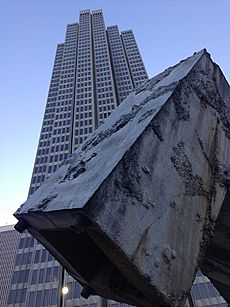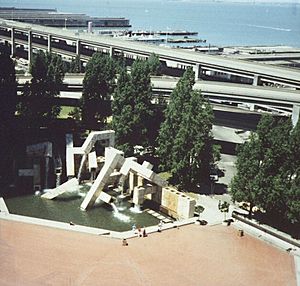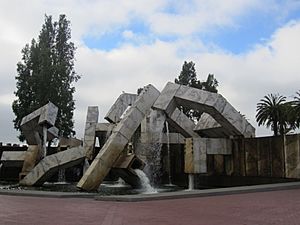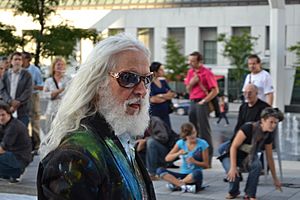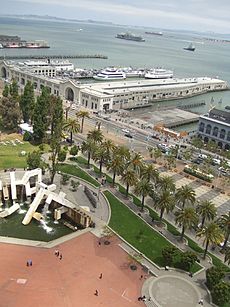Vaillancourt Fountain facts for kids
Quick facts for kids Vaillancourt Fountain |
|
|---|---|
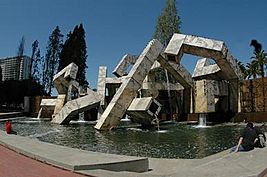 |
|
| Artist | Armand Vaillancourt |
| Completion date | April 21, 1971 |
| Type | Precast concrete |
| Dimensions | 12 m (40 ft) |
| Location | Justin Herman Plaza, San Francisco, California, United States |
The Vaillancourt Fountain, sometimes called Quebec libre!, is a very large fountain in Embarcadero Plaza in San Francisco. It was designed by the Québécois artist Armand Vaillancourt in 1971. The fountain is about 40 feet (12 meters) tall. It is made from square tubes of precast concrete.
Many people have found the fountain's modern look controversial. There have been several ideas to tear it down, but none have succeeded. In 1987, the famous band U2 held a free concert there. Their lead singer, Bono, spray-painted the fountain, which caused a lot of discussion.
Contents
Where to Find the Fountain
The Vaillancourt Fountain is in a very noticeable spot in downtown San Francisco. It sits in Justin Herman Plaza, right where Market Street meets The Embarcadero. The Hyatt Regency Hotel is next to the plaza. Other tall buildings of the Embarcadero Center are also nearby.
Across The Embarcadero is the historic Ferry Building. The eastern end of the California Street cable car line is on the other side of the Hyatt Regency Hotel.
When Armand Vaillancourt designed the fountain, a large elevated highway called the Embarcadero Freeway (or Interstate 480) ran along The Embarcadero. The fountain was designed with this freeway in mind. It was meant to draw people to a big public space. One critic called it "an act of defiant distraction" until the freeway was removed in 1991.
How the Fountain Was Designed and Built
The Vaillancourt Fountain was part of a big project to rebuild San Francisco in the 1950s and 1960s. This period saw the building of the Transamerica Pyramid and the BART train system.
M. Justin Herman, for whom the plaza is named, was a key person in this city rebuilding. He led the agency in charge of these changes. Lawrence Halprin, a famous landscape architect, was chosen to redesign Market Street. He designed Justin Herman Plaza and then hired Armand Vaillancourt to create the fountain. Vaillancourt, who was 38 years old, won a competition to design the fountain.
The fountain is about 40 feet (12 meters) tall. It weighs around 700 tons. It is made from square tubes of precast concrete. The fountain sits in a pool shaped like an uneven pentagon. It can pump up to 30,000 gallons (113,562 liters) of water per minute.
The fountain looks rough and unfinished, like concrete that hasn't been fully mixed. Its square pillars crisscross from a corner of the plaza. There are two bridges or walkways with stairs that let people stand between the tubes. From these spots, visitors can look out over the plaza and the city. There are also platforms at the pool level. These allow people to walk into the fountain and even behind the falling water. The fountain and plaza are always open to the public. The fountain cost about $310,000 to build. It was officially opened on April 22, 1971.
History of the Fountain
Just before the fountain was officially opened, someone painted "Quebec Libre" on it at night. This phrase refers to the Quebec sovereignty movement, which sought independence for Quebec. The graffiti was removed. But during the dedication ceremony, Armand Vaillancourt himself painted "Quebec Libre" on the fountain. When asked why he did this, he said, "This fountain is dedicated to all freedom. Free Quebec! Free East Pakistan! Free Viet Nam! Free the whole world!" Vaillancourt said his actions showed "power to the people." Since then, "Quebec Libre" has been another name for the fountain.
The band Flamin' Groovies performed at the fountain on September 19, 1979. This concert was broadcast on the radio station KSAN (FM).
U2's Concert in 1987
The famous rock band U2 was on their "Joshua Tree Tour" in 1987. They had already played concerts in San Francisco. On the morning of November 11, 1987, local radio stations announced that U2 would play a free concert that day. The stage was set up in front of the Vaillancourt Fountain. Within a few hours, about 20,000 people gathered in the plaza.
The band ended their nine-song performance with their hit song "Pride (In the Name of Love)". During the song, Bono, U2's lead singer, climbed onto the fountain. He spray-painted "Rock N Roll Stops The Traffic" on it. Mayor Dianne Feinstein was very upset. She had been working to stop graffiti in the city. She said, "I am disappointed that a rock star who is supposed to be a role model for young people chose to vandalize the work of another artist." Bono was given a citation for damaging property.
U2's manager, Paul McGuinness, said that Bono's action was "clearly in the spirit of the artwork itself." People who called radio talk shows were split on the issue. Younger listeners defended Bono, while older ones did not. Bono later apologized, saying, "I really do regret it. It was dumb." He explained that he thought he was honoring the artist's work. The band paid for the graffiti to be removed.
Armand Vaillancourt, the fountain's sculptor, flew from Quebec to California after the incident. He supported Bono's actions at U2's concert in Oakland a few days later. Vaillancourt said, "Good for him. I want to shake his hand." He even spray-painted "Stop the Madness" on the band's stage.
This event was shown in U2's 1988 movie Rattle and Hum. The footage of Bono spray-painting was shown during the band's opening song, "All Along the Watchtower". This has led some people to think that was the song playing when it happened.
Ideas to Tear Down the Fountain
After the 1989 Loma Prieta earthquake, the elevated Embarcadero Freeway was badly damaged. It was torn down and replaced with a street at ground level. An architect hired by the city suggested tearing down the fountain too, but no decision was made.
In 2004, San Francisco Supervisor Aaron Peskin again suggested demolishing the fountain. The water had been turned off for several years because of California's energy problems. Armand Vaillancourt immediately promised to "fight like a devil to preserve that work." Debra Lahane, from the San Francisco Arts Commission, said that "it succeeds as a work of art if it provokes dialogue and discussion." Within a few months, the water was flowing again, and plans to tear down the fountain were stopped.
Water On and Off
When the fountain opened in 1971, the water flow and people interacting with it were important parts of the artwork. Alfred Frankenstein, an art critic, noted that people could walk inside the fountain. He said this made it "unique and decidedly a success."
The water was turned off from 2001 to 2004. It was turned back on on August 2, 2004. San Francisco estimated that the electricity to run the fountain cost about $200,000 per year. Later, the city and a private company agreed to share the costs. The fountain was turned off again in November 2007 so that skaters at the Justin Herman Plaza ice rink would not get wet. It reopened on January 21, 2008.
Because of the 2011–17 California drought, all public fountains in San Francisco were turned off to save water. The Vaillancourt Fountain was turned off in 2014. Even after the drought ended, the city's Recreation and Park department said they didn't have enough money to fix the fountain. The estimated cost to get the water flowing again was about $500,000.
Charles Desmarais, an art critic, wrote in 2017 that the water is "essential" to the fountain. He said that without water, the fountain is "a sprawling, lifeless skeleton." He also noted that the walkways inside were blocked, and the area was full of trash. He argued that the city should fix the fountain.
On August 15, 2017, water was restored to the fountain as a test. The plan was for it to stay on until November, when the ice rink reopens. The water has been dyed blue to stop algae and bacteria from growing.
What People Think About the Fountain
The fountain has been controversial since it was built. Criticism of it has continued over the years. Thomas Hoving, a museum director, said the fountain had the boldness of Baroque sculpture. He added that "A work of art must be born in controversy." Justin Herman himself called it "one of the greatest artistic achievements in North America."
When it was dedicated, some people said the fountain might be a safety risk. Opponents handed out flyers calling it a "loathsome monstrosity" and "idiotic rubble." Art critic Alfred Frankenstein said that its "outrageousness and extravagance are part of its challenge." He also said it was meant for people to interact with, not just look at.
Another critic, Allan Temko, famously described it as if it had been "deposited by a giant concrete dog with square intestines." Critic Lloyd Skinner said it was "Stonehenge, unhinged, with plumbing troubles."
Other artists have also criticized the work. Sculptor Benny Bufano called it "a jumble of nothing." Artist Willard Cox compared it to "dynamited debris." Ruth Asawa noted in 1989 that the fountain's goal as art was lost. This happened because it was meant to hide and distract from the freeway.
The fountain has been called the "least revered modernist work of art" in San Francisco. Because of its large size, it "dominates the landscape" of Justin Herman Plaza. Some say its design was meant to "mock and mirror" the clumsy, double-decked Embarcadero Freeway.
Charles Birnbaum, an expert on Lawrence Halprin, said the architect always wanted people to interact with his water features. He said Justin Herman Plaza was meant to be a complete environment. The fountain was designed to attract people to an area that was cut off from the waterfront by the freeway.
Images for kids
-
Across The Embarcadero from the Ferry Building (2013)
-
Looking up at Four Embarcadero Center, rough texture retained (2012)
-
Reproduced in LEGO bricks at Miniland in Legoland California (2011)
See also
 In Spanish: Vaillancourt Fountain para niños
In Spanish: Vaillancourt Fountain para niños


